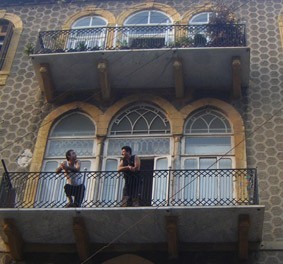Beirut’s architectural heritage is being savagely demolished, destroying along the way the collective memory that bonds the Lebanese together.
Since the early 90s and as soon as the civil war ceased, the whole of Lebanon gradually became one big national nonstop reconstruction site. The heart of Beirut was turned into a private company (Solidere), which presided over the urban planning and rehabilitation efforts. Although their work was largely criticized, either for having demolished conservable historic buildings or for destroying old valuable archaeological sites, the final result was a fine balance between economic gains, aesthetic concerns and historic considerations. Some projects were slightly relocated or revised, when conflicts occurred with existing archaeological sites or historic structures. Often times however, more practical and drastic measures were taken whereby bulldozers would simply wipe out whole areas!
A Real Estate boom soon followed, deciding the fate of what was left of Beirut’s architectural landmarks. Rich expatriates, Gulf Arab investors, as well as politicians involved in Real Estate drove prices up, encouraging property owners to sell their old homes to the highest bidders. Neighborhoods of traditional nature, which were once noted for their beautiful old mansions, their typical houses with triple-arched windows and red-tiled roof tops, their baroque rococo buildings, and even ottoman or colonial monuments, are now replaced with modern high-rise glass-glossy structures of concrete. Luxury apartments in such buildings usually range anywhere from three to five million dollars! The social and urban fabric is not being respected either, forever altering the face of the city. The beautiful gardens surrounding old homes are often also turned into car parkings, before again being replaced with more buildings.
To save what’s left of it, hundreds of conservationists and Lebanese activists joined forces with some of Beirut’s residents in a symbolic march on September the 25th 2010 that aimed to raise awareness and sound the alarm against the crimes, which were being committed against architectural treasures in the name of development and financial gain! The existing associations such as APSAD (Association for Protecting Natural Sites and Old Buildings in Lebanon) had failed to prevent the destruction of most houses and buildings of cultural value. Out of 1,200 old buildings inventoried by the Ministry of Culture since 1995, only 400 are left! It was time now for the youth to take action! Based on the initiative of two Facebook groups ‘Save Beirut Heritage’ and ‘Stop Destroying Our Heritage, their spokesperson Pascale Ingea lead the way in a long Candlelight Walk starting at Paul Bakery Gemmayze all the way to Mar Mikhael, where once stood the Cinema Vendome theatre.
The street was closed by the ISF for the event, and the crowds started gathering there around 5.30 pm. At first, the media outnumbered the participants but as the light dimmed, the numbers got less shy. You had the Lebanese scouts, local residents, the press…you could see a woman with her dog, or a mother with her child, hippie looking people, blue collars, white collars…they all came. After the national anthem, the march began. Large loudspeakers were mounted on a jeep and kept playing Fairuz and other patriotic songs. The participants were holding candles in remembrance of Beirut’s dying heritage, and would stop every now and then at one of the ‘crime scenes’, where historical buildings were pulled down. Some were also holding banners that read things like ‘Our History Is Not For Sale’ or Beirut Is Not Dubai’, or even ‘Haram, Beirut is Dying’. At each stop, they would announce their demands, which included new legislation to preserve heritage houses, official inventory of landmarks and buildings of high cultural value, urban planning and zoning, funds to support residents of old houses, green spaces etc..
The destruction of Lebanon’s architectural heritage is becoming systematic, and many landmarks like the pink house of al Manara, the traditional coffee house Ahwet el ezaz Gemmayze, the Beirut Dome, the 19th old century historic opera house in Tripoli ( masrah el inja) and many more all over Lebanon are still in danger. Other retro buildings of important cultural value such as the Carlton Hotel built in the 60s, have already disappeared, making room for an extravagant residential compound comprised of three towers.
Overall, the event was pathetically symbolic. The next step would be to stop demolitions before they occur, not just shed tears at the losses… and you can play a part in that!
What can you do? There is a hot-line you can use to report any old buildings being torn down so that activists can lobby and prevent that from happening!
Hotline Ministry of Culture: 01-612 299
Make sure you check our photo gallery if you missed the event!
